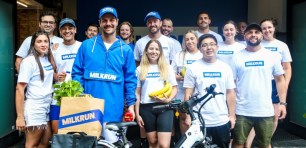
On Tuesday Milkrun announced it would be closing its doors by end of week. It was the last ‘instant’ grocery delivery startup to remain standing in Australia, and for some the news doesn’t come as a surprise.
There’s several potential contributions to the closure. The continued economic climate and rising cost of living means shoppers are more frugal than ever and are less likely to splash out on delivery services and the premiums attached to them.
There’s also the change in the VC market compared to the ‘perfect storm’ of 2021, and the beginning of 2022 when Milkrun landed $88 million in total capital in the space of a few months. The era of cheap money is well and truly over, at least for now.
There’s also the fact that the startup, and others like it that have since collapsed, launched during COVID lockdowns. People were relying more on delivery services for their everyday lives. And it’s hard to argue with a 10-minute delivery window.
But according to experts in field, there was a far simpler reason for why Milkrun didn’t work out, and one that was clear from the beginning: the numbers just didn’t add up.
The math didn’t work for Milkrun
Unlike food delivery platforms that rely on gig economy workers, Milkrun riders were salaried employees, with some even on full-time and part-time contracts.
Considering Australia has a relatively high minimum wage, that’s going to get expensive very quickly. It’s even more expensive when you consider the initial ‘under 10 minute’ delivery promise.
“Milkrun was engaging drivers as employees, so they were paying an hourly wage, paying superannuation and workers comp. Plus they had these warehouses and people that were doing the pick and pack,”Steve Orenstein, founder and CEO of Zoom2u and Locate2u, said in a call with SmartCompany.
“The math just didn’t make sense.”
“Whenever you look at this sort of stuff, you look at the number of deliveries that the driver can do within an hour and then how does that stack up versus the cost of completing that particular order, and just the cost of the driver in this instance.”
“The number of orders that you were going to have to complete in that hour just to break even just didn’t make sense from a maths point of view.”
Jason Andrew, a chartered accountant and co-founder of SBO Financial agrees.
“Australia does have a high minimum wage relative to other countries — and that’s good for our economy. That’s a good thing. But when it comes down to businesses models like this it makes it really hard. I think that’s why Deliveroo pulled out of the Australia market,” Andrew told SmartCompany.
“It’s very difficult to run a business model like this if you had fixed labour costs relative to variable labour costs, where the riders get paid per trip or delivery versus being on payroll whether they’d have 10 an hour or one.”
And there were of course other overheads such as expensive marketing. It all adds up.
According to reports, Milkrun was losing an average of $13 per completed order and acquiring each new customer cost the company around $57.
“The costs base they were running with was enormous. They had a huge staff in Australia, very large marketing budgets and probably very large development costs as well,” Orenstein says.
Australia doesn’t have the density to scale
One suggestion that Orenstein makes is that perhaps Milkrun thought it would have greater density, and orders would increase, once it had scaled further.
“But the level of density they needed just didn’t exist in the Australian market,” he says.
While instant grocery delivery startups are struggling across multiple markets around the world, some have found success.
“The countries where it does seem to work — not just having great business models, but they seem to be more viable — are ones in high density. Cities with skyrocketing high rises, everyone’s living in cramped apartments, and the geography or footprint of the cities are quite small,” Andrew says.
“In Australia we’re very dispersive, a very large country. The population isn’t as dense as some other cities like New York, Hong Kong or Singapore.”
Still, that doesn’t mean all delivery services are doomed in Australia. Just ones that follow this rapid delivery model. And more sadly, ones that have salaried employees without the sheer volume of orders to back it up.
“I think it’s absolutely possible to make money, it’s just about doing it efficiently,” Orenstein says.
“Customers will always want 10 minute delivery, but customers can’t always get what they want.”
Handpicked for you

Milkrun failed because it was “trying to do the right thing” by employees, union says



COMMENTS
SmartCompany is committed to hosting lively discussions. Help us keep the conversation useful, interesting and welcoming. We aim to publish comments quickly in the interest of promoting robust conversation, but we’re a small team and we deploy filters to protect against legal risk. Occasionally your comment may be held up while it is being reviewed, but we’re working as fast as we can to keep the conversation rolling.
The SmartCompany comment section is members-only content. Please subscribe to leave a comment.
The SmartCompany comment section is members-only content. Please login to leave a comment.